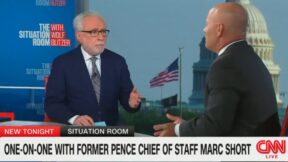
AP Photo/Susan Walsh
Elon Musk’s image has taken a brutal beating over his shambolic takeover of Twitter, which led business people to question his reputation for brilliance and journalists to rethink their reliance on the platform. But I come to praise Musk, not bury him even deeper, for in recent days he has done a startlingly good thing.
I refer to his April 29 tweet announcing that as of May Twitter will “allow media publishers to charge users on a per article basis with one click.” I hope people put aside their disdain for Musk’s politics (whatever they may be today) and his blue checkmark fiasco and pay attention to this development – for it portends the rebirth of the “micropayments” model that despite much logic has left publishers paralyzed with fear. If Musk pushes them across this Rubicon, it could revolutionize the media business model and offer a needed lifeline.
To understand why that’s needed, consider what has brought us to the brink.
In the late 1990s, many key publishers threw much of their content online for free in a move featuring the trappings of a huge miscalculation. For one thing, it arrogantly underestimated the disruptive power of the new medium (which they expected to remain a “storefront window” for print). For another, it ignored human nature – blithely creating a mindset that the internet is a place for free content where any revenue comes from ads. And the cardinal sin, perhaps, was taking those advertisers for granted; they of course soon found greener pastures in search and social, with their scale.
Within a decade it became clear that advertising alone could not support the existing media ecosystem. It also emerged that some platforms were monetizing user data, sparking concerns about privacy in the online ad environment, further clouding the picture.
So publishers began experimenting with paywalls. But successful paywalls – those that could charge many people real money for a real commitment – were few. The list tended to be limited to publications offering unique content tailored to relatively prosperous audiences — the Wall Street Journal, the Financial Times, the Economist, the New York Times, and their equivalents in non-English speaking places.
We are currently in a third phase, of surging paywall implementation. This is driven both by the financial need and by technological improvements that make online payment easy. But a basic tradeoff remains: paywalls add new revenue but might reduce overall traffic, thus lowering ad revenue which is mainly a function of that traffic.
The result has been mixed. Some publications can charge hundreds of dollars a year. That’s similar to what a Before Times print publication might have milked from a single reader. But the majority cannot get enough people to pay enough to cover the newsrooms that are deemed needed to produce a good product – defined by the number and quality of journalists. So we remain in an era of a great consolidation – the latest example being the shuttering of BuzzFeed News.
Recent data from the U.S. Census Bureau showed newspaper publishers collecting about $22.1 billion in revenue in 2020, less than half the figure of 2002 (and even less with inflation factored in). And the US Bureau of Labor Statistics recently released figures showing a 57 percent decline in newspaper newsroom employees since 2004, from 71,640 to 30,820. The Columbia Journalism Review found this amounts to a 62% drop in newsroom staff per 100,000 people. Similar dynamics are seen all over the world.
We cannot afford this. Ours is an era of rampant online misinformation. New AI tools, with their ability to spread false news that they picked up online with the linguistic grace of (a perhaps bureaucratic) Somerset Maugham, only deepen the need for real journalists verifying facts and connecting dots. So the collapse of the industry is terrible news.
To really address the issue, to genuinely restore sanity in the media’s business model, a major piece of the business model puzzle remains missing. Paywalls are generally analogous to subscriptions. Given that, they amount to a commitment (to keep returning to a site one has in effect paid for up front) that will repel and filter out much of the audience for any one piece of content. In the analog era, one could buy a paper without subscribing. It was possible to consume content on the fly while paying a small sum without commitment — micropayments.
I have long argued that people would pay on the fly if the system was frictionless. Few people reading an article with interest would not click on a button to pay a few cents more and continue – without subscriptions or passwords, substantial payments and IDs.
This requires some sort of universal ID. The idea that Twitter could offer that function is as good as blue checkmarks reform was bad. (Musk turned the checkmarks from a sign the account was verified into a sign the owner forked over some money – with the effect of celebrities refusing to do so and the AP deciding the checkmark was no longer a sign of a genuineness that could be used as a “source” without further independent vetting.)
With the help of partners who can provide payment gateways and devise sophisticated pricing models, Twitter and the publishers could create an ecosystem that also enables easy vertical mini-subscriptions – to a particular journalist, or to all content about a particular sports team).
The idea of paying a small sum to unlock an article or other piece of content also addresses another problem that is about to face social media: most and perhaps essentially all links to media content in posts and tweets will lead to dead ends. Most users trying to read one article will be asked to subscribe to publications they have no actual intention of revisiting (except if presented with another link). This “share-fail” or “link-fail” will badly clutter the social media experience. As I have written here before, we cannot subscribe to everything.
The Muskian micropayments would mean that we don’t have to.
Why have publishers avoided any real engagement with micropayments? Because they feared it would cannibalize subscriptions and net negative. But by having them be available not on their sites but via Twitter, that largely vanishes a concern.
The key would be to price everything optimally and possibly dynamically, and to make sure no party including Twitter is being too greedy. Surely that’s not so much to ask from the world’s occasionally richest man.
* * *
Dan Perry is Managing Partner of the Thunder11 communications firm, whose specializations include tech and healthcare. He was the top editor for the Associated Press in Europe, Africa and the Middle East. He is the author of two books, was among the first to develop a multilingual word processor, and co-founded a newspaper in Romania. Read his blog Ask Questions Later.
This is an opinion piece. The views expressed in this article are those of just the author.




